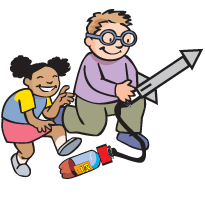Boston Children's Museum
308 Congress Street, Boston, MA 02210
617-426-6500
© Boston Children’s Museum 2025
Website Design by JackrabbitEngineering activities give kids a chance to develop problem solving and observations skills, to work with interesting and engaging tools and materials, and to learn how to work as a member of a team. In this activity, children get a chance to do all that—and to launch their creations into the air!
If you have not already done it, start with the Paper Rockets activity from this curriculum.
These rockets fly a long way, so this activity should be done outdoors or in a gymnasium or cafeteria. Keep the extra bicycle inner tube and 2-liter soda bottles on hand in case any part of the rocket launcher breaks. Set up a launch area outside or in a gymnasium or cafeteria. If you can, create a defined landing area with tape, chalk (if outside) or string. See Figure 1 in Resources below for two suggested layouts.

Ask your students what they did last time you did the Paper Rockets activity. Did their rockets fly far and straight? Do they think they can make them fly even farther and straighter? What are some things they might change about their design to make that happen?
Design, build and launch a rocket that travels as far and as straight as possible.
After 10–20 minutes, when teams have done some testing of their new designs, bring them all together to talk about what they have discovered. What have they changed about their rockets to help them fly? Have each team show their rocket to the other teams. Some things to look for (don’t tell teams about these tips – let them figure these things out themselves, or learn about them when other teams mention them):
Look for these design elements and if you see any teams using a closed nose, weight, fins or a particular launch angle, point it out and ask them to describe how their rocket flew before they added the fins, weight, etc and how it did afterward.
After hearing from each team, send them back to complete the construction of their rockets. If any of the design elements mentioned above did not come up in the large group conversation, find ways to ask each team questions that will help lead them to discovering these ideas. If you would like, encourage teams to come up with a name for their rockets and to add designs to them with markers before the final launch.
When all teams have completed their rockets, bring them to the launch area and have a big “Blast-Off” where each team will talk about their design, the choices they made and then will launch their creations. Use a measuring tape or yardsticks to measure the distances traveled.
Earth and Space science activities were developed with the support of NASA. This material is based upon work supported by NASA under grant award number NNX14AQ83G. Any opinions, findings, and conclusions or recommendations expressed in this material are those of the author(s) and do not necessarily reflect the views of the National Aeronautics and Space Administration (NASA).